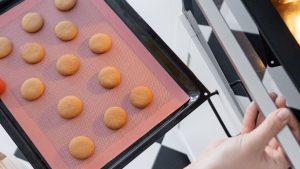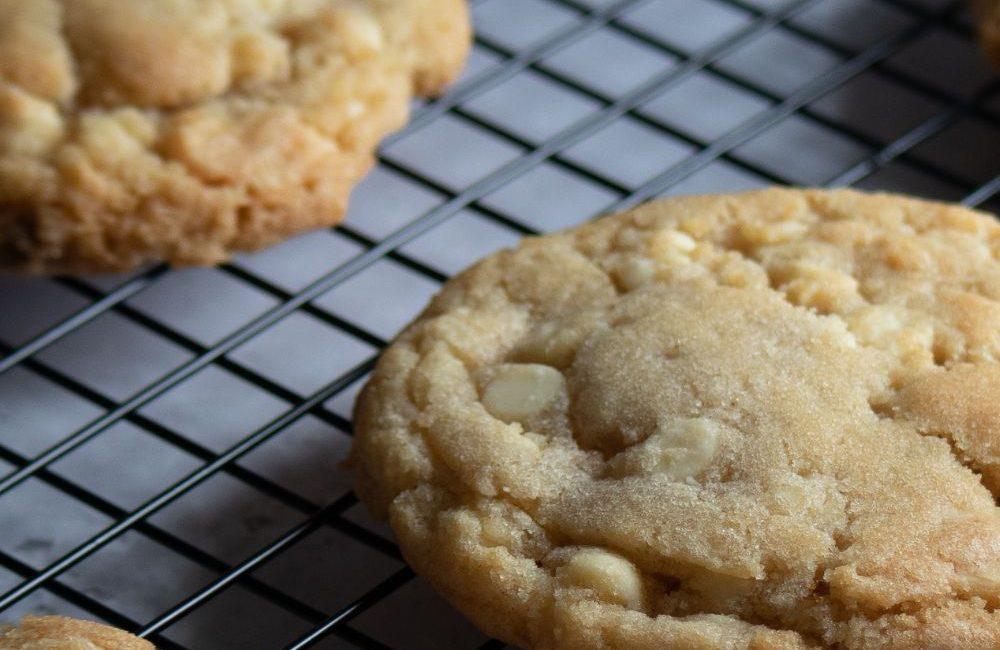In the quest to bake the perfect batch of peanut butter cookies, choosing the right oven temperature is a critical decision.
In this blog post, we’ll explore the science behind it and unveil the ideal baking temperature of 350°F (175°C).
We’ll delve into the reasons why this temperature is optimal and the key considerations to keep in mind for achieving peanut butter cookie perfection.
Unveiling the Ideal Setting: Optimal Baking Temperature for Peanut Butter Cookies.
The optimum baking temperature for peanut butter cookies is typically around 350°F (175°C).
This temperature is chosen for several reasons, taking into consideration both the science of baking and the desired cookie characteristics:
Even Baking: 350°F provides a moderate and even heat distribution in the oven, allowing the cookies to bake uniformly.
This ensures that the cookies are cooked consistently throughout, avoiding undercooked centers or overcooked edges.
Maillard Reaction: The Maillard reaction is a complex chemical reaction that occurs between amino acids and reducing sugars when exposed to heat.
This reaction is responsible for the browning and development of rich flavors in baked goods. 350°F is an ideal temperature to promote the Maillard reaction without burning the cookies.
Texture: Baking at this temperature helps create the desired texture in peanut butter cookies.
It allows them to spread and flatten slightly while maintaining a chewy or slightly crispy texture, depending on the recipe.
Nutty Flavor: Peanut butter cookies contain a high-fat ingredient, peanut butter.
Baking at 350°F helps release and enhance the nutty flavors of the peanut butter without scorching it.
Food Safety: Baking at this temperature ensures that the cookies reach a sufficient internal temperature to kill harmful bacteria and make them safe to consume.

Considerations when baking peanut butter cookies at 350°F:
- Time: The baking time can vary depending on the size and thickness of the cookies. It’s usually around 10-12 minutes, but you should monitor them closely. They are done when they are lightly golden brown around the edges.
- Cookie Size: Smaller cookies may require slightly less time, while larger cookies may need a bit more. Adjust the baking time accordingly.
- Oven Variability: Keep in mind that ovens can have temperature variations, so it’s a good practice to use an oven thermometer to ensure your oven is truly at 350°F.
- Baking Sheet: Consider using parchment paper or a silicone baking mat on your baking sheet to prevent the cookies from sticking and ensure even baking.
In other words, baking peanut butter cookies at 350°F is a well-balanced choice that promotes even baking, flavor development, and a desirable texture while ensuring food safety.
It’s a temperature that has been widely tested and proven successful for this classic cookie.
Let’s dive deeper and elaborate further on all the points mentioned here.
First, let me delve deeper into the concepts of even baking and the Maillard reaction to explain their significance at 350°F when making peanut butter cookies:
1. Even Baking:
When you bake cookies, you want them to be uniformly cooked, with a consistent texture throughout. This is where the concept of even baking comes into play.
At 350°F (175°C), the heat in the oven is distributed moderately and evenly. This means that the temperature doesn’t fluctuate too much, and there are no extreme hotspots within the oven.
This uniformity of heat is crucial for baking because it ensures that each part of the cookie is subjected to the same conditions.
Why is this important?
Consistency: Uniform baking temperatures help ensure that the cookies come out consistent in texture and appearance. You won’t end up with cookies that are burnt on one side and undercooked on the other.
Even Spreading: Peanut butter cookie dough contains fats and sugars that melt during baking. The even heat encourages the dough to spread evenly on the baking sheet, resulting in cookies that are not too thick or too thin.
Moisture Evaporation: The even heat also facilitates the controlled evaporation of moisture from the cookies. This helps in achieving the desired texture, whether it’s chewy or slightly crispy, by controlling the moisture content.
2. Maillard Reaction:
The Maillard reaction is a complex chemical reaction that occurs when certain amino acids (building blocks of proteins) and reducing sugars (sugars that can react with other compounds) are exposed to heat.
This reaction is responsible for the browning and development of rich flavors in baked goods, including peanut butter cookies.
Here’s a deeper look:
Browning: The Maillard reaction is what gives baked goods their appealing golden-brown color. At 350°F, the Maillard reaction occurs at a rate that allows the cookies to achieve this desirable color without becoming overly dark or burnt.
Flavor Development: This reaction also produces a wide range of flavor compounds, some of which are responsible for the delicious, nutty, and caramel-like flavors you associate with well-baked cookies. These flavors enhance the overall taste experience.
Texture: Beyond color and flavor, the Maillard reaction contributes to the development of a slightly crispy exterior and a tender, flavorful interior in peanut butter cookies, which is highly sought after.
In thend , baking peanut butter cookies at 350°F ensures that the cookies are exposed to a consistent and moderate heat distribution, promoting even baking and controlled moisture evaporation.
It also allows the Maillard reaction to occur, resulting in the desired color, flavor, and texture in the cookies.
This combination of even baking and the Maillard reaction at this temperature is the key to achieving perfect peanut butter cookies.
let’s explore the concepts of texture, nutty flavor enhancement, and food safety in greater depth when baking peanut butter cookies at 350°F:
3. Texture:
Baking peanut butter cookies at 350°F is instrumental in achieving the desired texture, which can be either chewy or slightly crispy, depending on the recipe and baking time.
Spread and Flattening: Peanut butter cookie dough typically contains a significant amount of fat from the peanut butter and butter or margarine. At 350°F, this fat starts to melt early in the baking process.
As the fat liquifies, it coats the flour and other dry ingredients, helping the cookies spread and flatten slightly on the baking sheet.
This spreading effect contributes to the cookie’s characteristic shape and size.
Chewiness: The moderate heat at 350°F allows the cookies to cook through gradually. This gradual cooking helps maintain a chewy texture in the center of the cookies, which is a desirable characteristic of many peanut butter cookie recipes.
Slight Crispiness: While the cookies remain chewy in the center, the edges are exposed to slightly higher temperatures, leading to a gentle crispiness along the outer perimeter of the cookies.
This contrast in texture—chewy centers and crisp edges—is a hallmark of well-baked peanut butter cookies.
4. Nutty Flavor Enhancement:
Peanut butter is a key ingredient in peanut butter cookies, and it contains fats and proteins that contribute to the cookie’s flavor profile. Baking at 350°F enhances the nutty flavors in several ways:
Fat Emulsification: The moderate heat at 350°F causes the fats in the peanut butter to melt and blend with other ingredients in the dough.
This emulsification process disperses the nutty flavor throughout the cookie dough, ensuring a consistent and pronounced peanut butter taste in every bite.
Maillard Reaction: As mentioned earlier, the Maillard reaction occurs at this temperature and plays a significant role in flavor development. It not only contributes to the browning of the cookies but also enhances the nutty and caramel-like notes from the peanut butter, adding depth and complexity to the flavor.
5. Food Safety:
Baking at 350°F also addresses food safety concerns:
Internal Temperature: To ensure that the cookies are safe to consume, it’s important that they reach a sufficient internal temperature.
Baking at 350°F allows the cookies to heat evenly and achieve this internal temperature, effectively killing any harmful bacteria or pathogens that might be present in the raw cookie dough.
In summary, baking peanut butter cookies at 350°F results in the desired texture, with chewy centers and slightly crispy edges, while also enhancing the nutty flavor of the peanut butter.
Additionally, it ensures food safety by reaching a sufficient internal temperature during baking, making the cookies both delicious and safe to enjoy.
A tabular on this topic here.
Here’s a tabular summary of the optimum baking temperature for peanut butter cookies, along with the reasons and considerations for using this temperature:
| Aspect | Optimum Baking Temperature | Reasons | Considerations |
|---|---|---|---|
| Even Baking | 350°F (175°C) | – Provides moderate and even heat distribution, ensuring uniform baking. – Prevents undercooked centers or overcooked edges. | Monitor baking time for different sizes. Use oven thermometer for accuracy. |
| Maillard Reaction | 350°F (175°C) | – Promotes the Maillard reaction for browning and rich flavor development. – Ideal temperature for flavor enhancement without burning. | Achieves desirable color and flavor. |
| Texture | 350°F (175°C) | – Facilitates even spreading and slight flattening of cookies. – Maintains chewy or slightly crispy texture, depending on recipe. | Adjust baking time for desired texture. |
| Nutty Flavor Enhancement | 350°F (175°C) | – Emulsifies peanut butter fats, distributing nutty flavor evenly. – Maillard reaction enhances nutty and caramel-like notes. | Ensures a pronounced peanut butter taste. |
| Food Safety | 350°F (175°C) | – Reaches sufficient internal temperature to kill harmful bacteria. | Ensures cookies are safe to consume. |
Baking peanut butter cookies at 350°F provides a balanced approach, offering even baking, flavor development, texture control, nutty flavor enhancement, and food safety. It’s a well-established temperature choice for achieving the best results when making these delicious cookies.
Conclusion.
In conclusion, the optimum baking temperature for peanut butter cookies is 350°F (175°C).
This temperature ensures even baking, promotes the Maillard reaction for flavor enhancement, maintains the desired texture, enhances the nutty flavor, and ensures food safety.
It’s a well-balanced choice that results in delicious and safe-to-consume peanut butter cookies.

Whether you’re a passionate baker or simply seeking sweet inspiration, I’m here to provide you with valuable insights, mouthwatering recipes, expert tips, and more to make your cookie adventures with Mike truly delightful and scrumptious. You are on the true exciting cookie-filled side.




